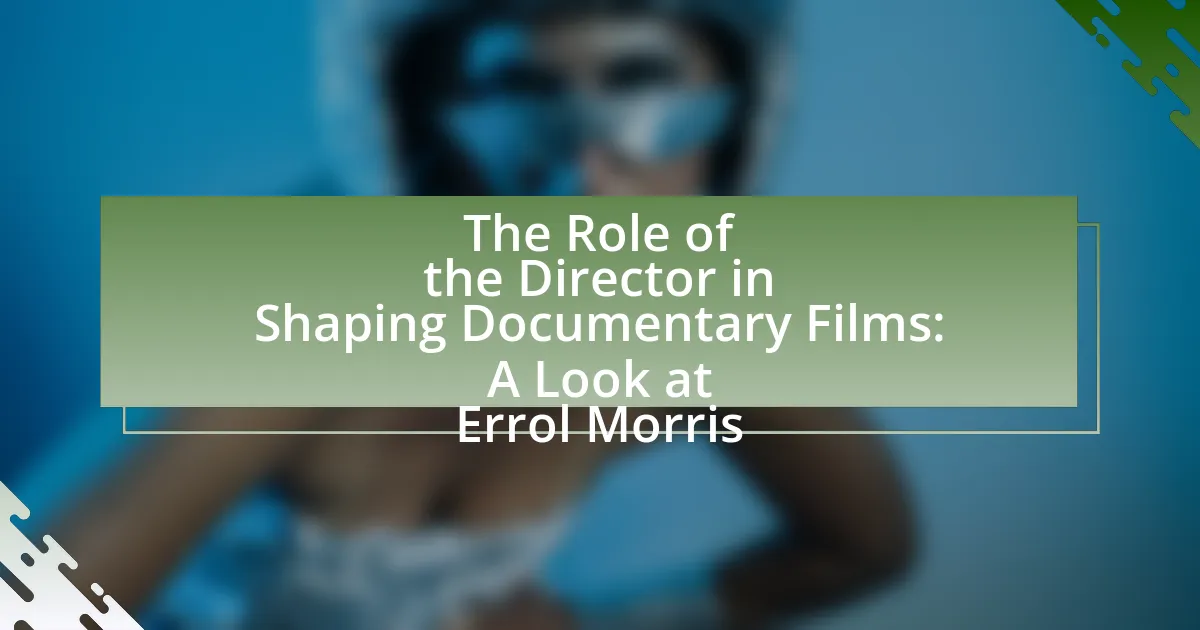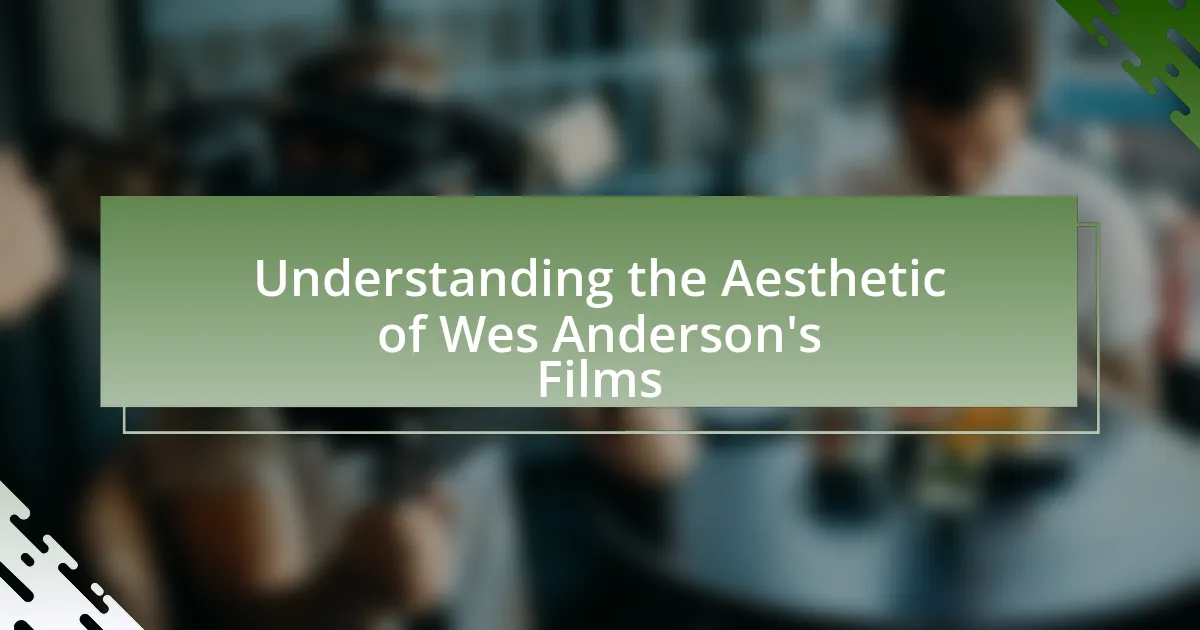Ava DuVernay is a prominent filmmaker known for her significant contributions to cinema through innovative storytelling techniques and a focus on social justice themes. This article examines her key cinematic innovations, including the use of diverse perspectives, non-linear narratives, and rich character development, as seen in films like “Selma” and “13th.” It also highlights her commitment to representation in casting and crew, the impact of technology on her filmmaking style, and the historical narratives she explores. Furthermore, the article discusses how DuVernay’s work inspires activism and awareness, challenges traditional gender roles, and influences emerging filmmakers, ultimately reshaping the landscape of the film industry.

What are the key cinematic innovations introduced by Ava DuVernay?
Ava DuVernay has introduced key cinematic innovations such as the use of diverse storytelling perspectives and the integration of social justice themes into mainstream cinema. Her film “Selma” (2014) redefined historical narratives by centering on the experiences of marginalized communities, showcasing the civil rights movement through a lens that emphasizes personal and collective struggle. Additionally, DuVernay’s work on “13th” (2016) innovatively blended documentary and narrative techniques to explore systemic racism and mass incarceration, utilizing archival footage and expert interviews to create a compelling argument. These innovations have not only expanded the representation of African American stories in film but have also influenced the broader discourse on race and justice in America.
How has Ava DuVernay changed the narrative structure in film?
Ava DuVernay has changed the narrative structure in film by employing non-linear storytelling and emphasizing diverse perspectives. Her film “Selma” utilizes a historical event to explore multiple viewpoints, allowing for a richer understanding of the civil rights movement. Additionally, in “A Wrinkle in Time,” she integrates themes of intersectionality and identity, showcasing characters from various backgrounds and experiences. This approach not only challenges traditional narrative forms but also broadens the representation of marginalized voices in cinema, as evidenced by her focus on female protagonists and complex character arcs.
What techniques does she use to enhance storytelling?
Ava DuVernay enhances storytelling through techniques such as non-linear narratives, rich character development, and visual symbolism. Non-linear narratives allow her to present stories in a way that engages the audience by revealing key plot points out of chronological order, creating suspense and deeper emotional connections. Her focus on rich character development ensures that characters are multi-dimensional, allowing viewers to empathize with their struggles and triumphs. Additionally, DuVernay employs visual symbolism to convey complex themes and emotions, using imagery that resonates with the audience on a deeper level. These techniques are evident in her works like “Selma” and “A Wrinkle in Time,” where she effectively combines these elements to create impactful narratives.
How do her narrative choices reflect social issues?
Ava DuVernay’s narrative choices reflect social issues by centering marginalized voices and highlighting systemic injustices. For instance, in “13th,” she employs a documentary format that intertwines historical footage with contemporary interviews to expose the racial disparities in the U.S. prison system, illustrating how mass incarceration is a continuation of racial oppression. This choice not only informs viewers about the historical context but also prompts critical discussions about race, justice, and policy. Additionally, her film “Selma” uses a dramatized retelling of the civil rights movement to emphasize the ongoing struggle for equality, showcasing the importance of activism and community in confronting social injustices. These narrative strategies effectively engage audiences with pressing social issues, making them more relatable and urgent.
What role does representation play in DuVernay’s work?
Representation plays a crucial role in Ava DuVernay’s work by prioritizing diverse narratives and amplifying underrepresented voices. DuVernay’s films, such as “Selma” and “13th,” focus on the experiences of marginalized communities, particularly African Americans, thereby challenging mainstream portrayals in cinema. Her commitment to representation is evident in her initiatives, like the ARRAY organization, which promotes films by women and people of color. This focus not only enriches the storytelling landscape but also fosters greater empathy and understanding among audiences, as evidenced by the critical acclaim and cultural impact of her projects.
How does she prioritize diversity in casting and crew?
Ava DuVernay prioritizes diversity in casting and crew by actively seeking to include underrepresented groups in her projects. She emphasizes the importance of authentic representation, which is evident in her films such as “Selma” and “A Wrinkle in Time,” where she cast actors from diverse backgrounds in leading roles. Additionally, DuVernay has been vocal about her commitment to hiring women and people of color in key production roles, as demonstrated by her initiative, ARRAY, which focuses on promoting films by women and people of color. This approach not only enriches the storytelling but also reflects her belief that diverse perspectives are essential to the filmmaking process.
What impact does this representation have on audiences?
The representation in Ava DuVernay’s work significantly impacts audiences by fostering greater empathy and understanding of marginalized communities. This is evident in her films, such as “Selma” and “13th,” which highlight historical injustices and systemic racism, prompting viewers to engage critically with social issues. Research indicates that diverse representation in media can enhance audience awareness and promote social change, as seen in studies by the Geena Davis Institute on Gender in Media, which found that inclusive narratives lead to increased empathy among viewers. Thus, DuVernay’s cinematic innovations not only entertain but also educate and inspire action among audiences.
How has technology influenced DuVernay’s filmmaking style?
Technology has significantly influenced Ava DuVernay’s filmmaking style by enabling her to utilize innovative storytelling techniques and enhance visual aesthetics. DuVernay has embraced digital cinematography, which allows for greater flexibility in shooting and editing, as seen in her work on “Selma” and “A Wrinkle in Time.” The use of advanced editing software has also facilitated her ability to weave complex narratives and incorporate diverse perspectives, reflecting her commitment to social justice themes. Furthermore, DuVernay’s engagement with platforms like Netflix has expanded her reach and allowed for more inclusive representation in her films, showcasing the impact of technology on distribution and audience engagement.
What innovative technologies has she utilized in her films?
Ava DuVernay has utilized innovative technologies such as virtual reality (VR) and advanced digital cinematography in her films. For instance, her project “The 13th” employed high-definition digital footage and innovative editing techniques to enhance storytelling, while her VR experience “The Lion’s Share” showcased immersive storytelling through cutting-edge VR technology. These technologies not only elevate the visual experience but also engage audiences in new and interactive ways, demonstrating her commitment to pushing the boundaries of traditional filmmaking.
How does technology enhance the visual storytelling in her work?
Technology enhances the visual storytelling in Ava DuVernay’s work by enabling innovative techniques such as high-definition cinematography, advanced editing software, and immersive sound design. These tools allow her to create visually striking narratives that engage audiences on multiple sensory levels. For instance, in “A Wrinkle in Time,” DuVernay utilized cutting-edge visual effects and CGI to bring fantastical elements to life, enhancing the emotional depth and thematic resonance of the story. This integration of technology not only elevates the aesthetic quality of her films but also deepens the viewer’s connection to the characters and their journeys.
What themes are prevalent in Ava DuVernay’s films?
Ava DuVernay’s films prominently explore themes of racial injustice, identity, and social activism. Her work, such as “Selma,” highlights the struggle for civil rights, showcasing historical events that emphasize systemic oppression and the fight for equality. Additionally, “13th” delves into the intersection of race and the criminal justice system, illustrating how mass incarceration disproportionately affects African Americans. DuVernay’s storytelling often centers on the personal experiences of marginalized communities, reflecting broader societal issues and encouraging dialogue around these critical themes.
How does DuVernay address social justice in her films?
Ava DuVernay addresses social justice in her films by centering narratives that highlight systemic inequality and the experiences of marginalized communities. For instance, her film “13th” explores the intersection of race, justice, and mass incarceration in the United States, providing historical context and statistical evidence that illustrates the disproportionate impact of the criminal justice system on African Americans. Additionally, DuVernay’s work in “Selma” emphasizes the civil rights movement, showcasing the struggles and triumphs of activists fighting for voting rights, thereby raising awareness about ongoing social justice issues. Through these films, DuVernay not only tells compelling stories but also encourages dialogue and reflection on critical social issues.
What specific films highlight her focus on social issues?
Ava DuVernay’s films that highlight her focus on social issues include “Selma,” “13th,” and “When They See Us.” “Selma” portrays the civil rights movement and the struggle for voting rights, specifically focusing on the 1965 Selma to Montgomery marches. “13th” examines the intersection of race, justice, and mass incarceration in the United States, providing a historical context for systemic racism. “When They See Us” tells the story of the Central Park Five, addressing issues of wrongful conviction and racial profiling. Each film effectively raises awareness about critical social issues through powerful storytelling and historical accuracy.
How do her films inspire activism and awareness?
Ava DuVernay’s films inspire activism and awareness by addressing social justice issues and amplifying marginalized voices. For instance, her documentary “13th” explores the intersection of race, justice, and mass incarceration in the United States, leading to increased public discourse and activism surrounding criminal justice reform. The film’s critical reception and educational impact have prompted discussions in various forums, including academic settings and community organizations, highlighting systemic inequalities. Additionally, her narrative film “Selma” dramatizes the civil rights movement, motivating audiences to engage in contemporary social movements, evidenced by the resurgence of activism following its release. These films serve as catalysts for awareness and action, effectively mobilizing viewers to confront societal injustices.
What historical narratives does DuVernay explore?
Ava DuVernay explores historical narratives centered on systemic racism, civil rights, and social justice. Her film “13th” examines the intersection of race, justice, and mass incarceration in the United States, highlighting how the 13th Amendment allowed for the continuation of slavery through incarceration. Additionally, “Selma” portrays the 1965 voting rights marches led by Martin Luther King Jr., emphasizing the struggle for African American voting rights. These narratives are grounded in factual historical events and figures, providing a critical lens on America’s racial history and its ongoing implications.
How does she reinterpret historical events through her lens?
Ava DuVernay reinterprets historical events through her lens by emphasizing marginalized voices and presenting narratives that challenge dominant historical perspectives. For instance, in her film “13th,” she explores the intersection of race, justice, and mass incarceration in the United States, highlighting how systemic racism has evolved from slavery to modern-day penal systems. This approach is supported by her use of archival footage and expert interviews, which provide a comprehensive analysis of the historical context and its implications on contemporary society. By focusing on these often-overlooked aspects, DuVernay reshapes the viewer’s understanding of history, making it more inclusive and reflective of diverse experiences.
What significance do these narratives hold in contemporary society?
The narratives created by Ava DuVernay hold significant importance in contemporary society as they challenge dominant cultural narratives and promote social justice. DuVernay’s films, such as “Selma” and “13th,” address systemic racism and historical injustices, fostering critical conversations about race and equality. For instance, “13th” explores the intersection of race, justice, and mass incarceration, revealing that the U.S. prison population is disproportionately composed of African Americans, which is a direct consequence of policies rooted in racial discrimination. This focus on marginalized voices not only raises awareness but also inspires activism and policy change, making her work pivotal in shaping societal perspectives on these issues.
How does DuVernay’s work challenge traditional gender roles in cinema?
Ava DuVernay’s work challenges traditional gender roles in cinema by centering strong, complex female characters and highlighting their narratives in a predominantly male-driven industry. For instance, in “Selma,” DuVernay not only portrays the historical figure of Coretta Scott King as a pivotal character but also emphasizes her emotional and political struggles, showcasing women’s roles in the civil rights movement. Additionally, DuVernay’s series “Queen Sugar” features a predominantly female cast and crew, which disrupts the conventional male-centric storytelling model and provides a platform for women’s voices and experiences. This approach not only redefines the representation of women in film but also encourages a broader dialogue about gender equality in the industry.
What female characters stand out in her films?
Ava DuVernay’s films prominently feature strong female characters such as Ann Atwater in “The Best of Enemies” and Ava DuVernay herself in “The 13th.” Ann Atwater, portrayed by Taraji P. Henson, is a civil rights activist who plays a crucial role in advocating for school desegregation in the 1970s, showcasing resilience and leadership. In “The 13th,” DuVernay highlights the systemic injustices faced by African American women, emphasizing their struggles and contributions to the fight for equality. These characters exemplify DuVernay’s commitment to portraying complex, empowered women in her narratives, reflecting real historical figures and their impact on society.
How do these characters contribute to the overall message of her films?
Ava DuVernay’s characters significantly contribute to the overall message of her films by embodying themes of resilience, social justice, and the complexity of identity. For instance, in “Selma,” the characters represent the struggle for civil rights, illustrating the importance of collective action and perseverance in the face of systemic oppression. This portrayal reinforces the film’s message about the ongoing fight for equality and the necessity of activism. Similarly, in “13th,” the characters highlight the intersection of race and the criminal justice system, emphasizing the historical context of racial inequality in America. This character-driven narrative effectively communicates the urgency of addressing these societal issues, making the films not only engaging but also impactful in sparking dialogue and awareness around critical social themes.

What impact has Ava DuVernay had on the film industry?
Ava DuVernay has significantly impacted the film industry by championing diverse storytelling and advocating for representation. She became the first African American woman to direct a film with a budget over $100 million with “A Wrinkle in Time,” showcasing the potential for inclusive narratives in mainstream cinema. Additionally, her work on “Selma” and the documentary “13th” has sparked critical conversations about race and justice, influencing both audiences and filmmakers. DuVernay’s establishment of ARRAY, a distribution company focused on films by people of color and women, further emphasizes her commitment to changing the landscape of the industry, making it more equitable and reflective of diverse experiences.
How has she influenced emerging filmmakers?
Ava DuVernay has influenced emerging filmmakers by championing diverse narratives and advocating for representation in the film industry. Her work, particularly in films like “Selma” and “13th,” has demonstrated the importance of telling stories from underrepresented perspectives, inspiring new filmmakers to explore themes of social justice and identity. DuVernay’s establishment of the ARRAY Alliance, which focuses on distributing films by women and people of color, further empowers emerging filmmakers by providing them with resources and platforms to showcase their work. This commitment to inclusivity and innovation has set a precedent that encourages a new generation of filmmakers to pursue their unique voices and stories.
What initiatives has she created to support new voices in cinema?
Ava DuVernay has created several initiatives to support new voices in cinema, including the ARRAY Alliance, which focuses on amplifying the work of women and people of color in film. ARRAY provides resources such as funding, mentorship, and distribution opportunities to emerging filmmakers. Additionally, DuVernay launched the “Ava DuVernay Fellowship,” aimed at nurturing diverse talent in the industry through hands-on experience and professional development. These initiatives are designed to address the systemic barriers faced by underrepresented creators in the film industry.
How does her success pave the way for future filmmakers?
Ava DuVernay’s success paves the way for future filmmakers by demonstrating that diverse storytelling can achieve critical and commercial success. Her films, such as “Selma” and “13th,” have not only garnered numerous awards but also sparked important conversations about race and justice, proving that narratives from underrepresented voices resonate with audiences. This success encourages emerging filmmakers to pursue their unique perspectives, knowing that there is a viable path to recognition and impact in the industry. Additionally, DuVernay’s initiatives, like the ARRAY distribution company, actively support and promote films by women and people of color, further expanding opportunities for future filmmakers to share their stories.
What recognition has DuVernay received for her work?
Ava DuVernay has received numerous accolades for her work, including the 2017 Primetime Emmy Award for Outstanding Documentary or Nonfiction Special for “13th.” Additionally, she was the first African American woman to win the Best Director award at the Sundance Film Festival in 2012 for “Middle of Nowhere.” DuVernay’s film “Selma” earned her a nomination for the Academy Award for Best Picture, further solidifying her impact in the film industry. These recognitions highlight her significant contributions to cinema and her role in advancing representation in storytelling.
What awards and nominations highlight her contributions to film?
Ava DuVernay has received numerous awards and nominations that underscore her significant contributions to film, including the 2017 Primetime Emmy Award for Outstanding Documentary or Nonfiction Special for “13th.” Additionally, she was nominated for an Academy Award for Best Documentary Feature for the same film. DuVernay also won the Best Director award at the Sundance Film Festival for “Middle of Nowhere” in 2012, making her the first African American woman to win that honor. Her work has been recognized by the NAACP Image Awards, where she has received multiple nominations and wins, further highlighting her impact on the cinematic landscape.
How do these accolades reflect her influence in the industry?
Ava DuVernay’s accolades, including her historic Oscar nomination for Best Director and the success of her films like “Selma” and “13th,” reflect her significant influence in the film industry by breaking barriers for women and people of color. These achievements demonstrate her ability to tackle complex social issues through cinema, garnering critical acclaim and audience engagement. For instance, “13th” received an Emmy Award and was nominated for an Academy Award, showcasing her impact on both television and film narratives. Her recognition as a trailblazer has inspired a new generation of filmmakers, further solidifying her role as a transformative figure in the industry.
What lessons can filmmakers learn from Ava DuVernay’s approach?
Filmmakers can learn the importance of storytelling authenticity and representation from Ava DuVernay’s approach. DuVernay emphasizes the need for diverse narratives that reflect the complexities of marginalized communities, as seen in her films like “Selma” and “13th.” Her commitment to social justice and historical accuracy demonstrates that filmmakers can create impactful cinema by prioritizing genuine voices and experiences. This approach not only resonates with audiences but also fosters a deeper understanding of societal issues, as evidenced by the critical acclaim and cultural conversations sparked by her work.
How can aspiring filmmakers incorporate her techniques into their work?
Aspiring filmmakers can incorporate Ava DuVernay’s techniques into their work by focusing on authentic storytelling, diverse representation, and innovative visual styles. DuVernay emphasizes the importance of narratives that reflect underrepresented voices, encouraging filmmakers to explore stories that resonate with marginalized communities. For instance, her film “Selma” showcases the civil rights movement through a personal lens, illustrating how personal stories can enhance historical narratives. Additionally, DuVernay employs unique visual compositions and color palettes, as seen in “A Wrinkle in Time,” which can inspire filmmakers to experiment with aesthetics to convey emotional depth. By studying her approach to character development and thematic exploration, filmmakers can create more impactful and resonant films.
What best practices can be derived from her storytelling methods?
Ava DuVernay’s storytelling methods emphasize authenticity, emotional resonance, and inclusivity. These best practices can be derived from her approach:
-
Authenticity: DuVernay prioritizes genuine narratives that reflect real experiences, which fosters a deeper connection with the audience. For instance, her film “Selma” authentically portrays the civil rights movement, drawing from historical events and personal stories.
-
Emotional Resonance: She effectively uses character development to evoke empathy, allowing viewers to engage emotionally with the story. In “13th,” the exploration of systemic racism is presented through personal testimonies, making the issue relatable and impactful.
-
Inclusivity: DuVernay champions diverse voices and perspectives, ensuring representation in her narratives. This is evident in her work on “Queen Sugar,” where she employs a predominantly female directing team, highlighting the importance of varied viewpoints in storytelling.
These practices not only enhance the narrative quality but also contribute to a broader understanding of social issues, making her storytelling methods exemplary in contemporary cinema.




